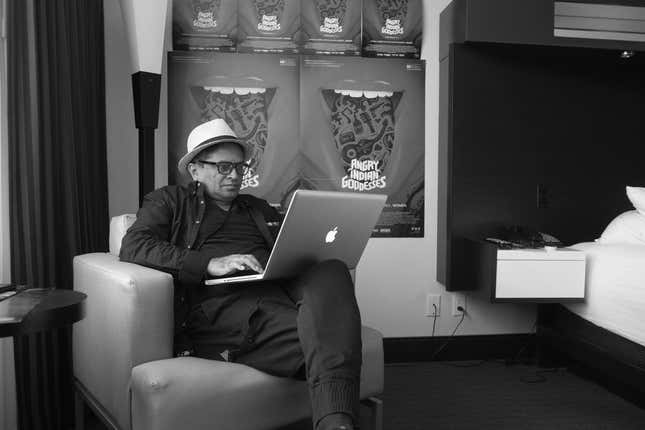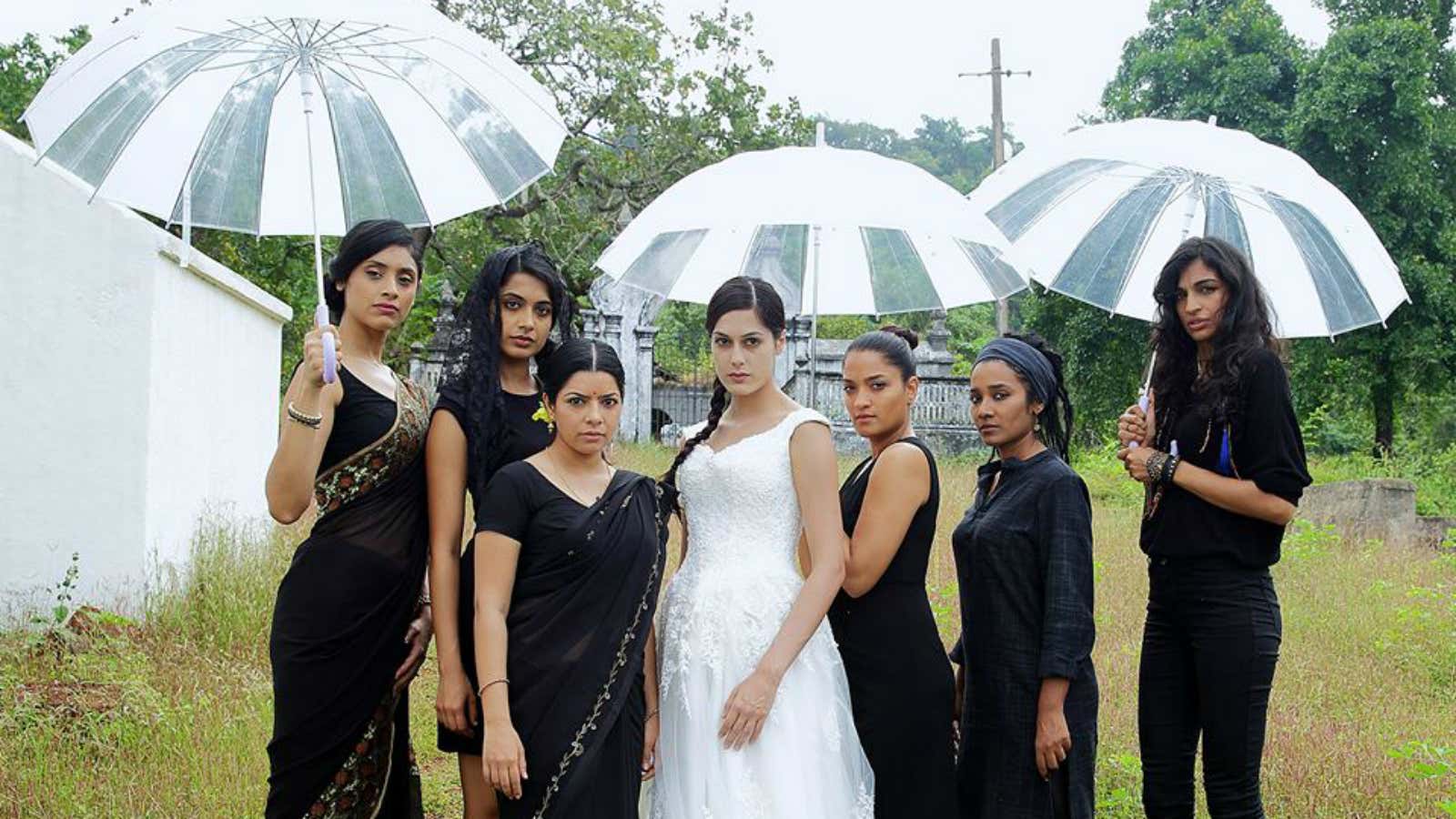This post has been updated.
At this year’s Toronto International Film Festival—North America’s biggest film festival—a Hindi drama emerged as one of the biggest crowd-pleasers.
Angry Indian Goddesses, touted as the first female buddy film from India, won the first runner-up position for the People’s Choice Awards. Among other films, it was competing with Johnny Depp’s Black Mass and Matt Damon’s The Martian. The film festival in Toronto initiates the awards season, and films that have been screened here—including Danny Boyle’s Slumdog Millionaire—have ended up winning at the Oscars.
Today, Dec. 04, Angry Indian Goddesses releases in theatres across India.

The film is about seven modern Indian women, who come together in a house in Goa for a wedding. While Hindi cinema has a long tradition of making movies on male friendships—think Sholay, Dil Chahta Hai, 3 Idiots—there have been hardly any female-led films in this genre.
Angry Indian Goddesses has been directed by 49-year-old Pan Nalin, an internationally acclaimed Indian director, known for his documentaries (The Devadasis, Ayurveda: Art of Being) and debut film, Samsara.
The film—which stars Sandhya Mridul, Tannishtha Chatterjee and five other women in the lead—could be Nalin’s entry to the mainstream film industry in the country.
In a FaceTime interview with Quartz, Nalin talks about his seven goddesses and whether he is ready for Bollywood.
His answers have been lightly edited.
Why a female buddy film?
I had had strong women characters in my earlier films, like Samsara and Valley of Flowers. After those films, I wanted to do a woman-as-hero film. I worked on quite a few screenplays, like I had developed Rani of Jhansi, then the story of Putlibai (Gandhi), the story of a modern woman, but it was just impossible to get financing. This was about seven years ago, when my associate and I went around convincing a lot of people. But what I got was: “Since Rekha’s Umrao Jaan, no film has worked.” Then films like Kahaani and Queen did well at the box office, but still we didn’t find any money for our idea and concept.
The idea came to me just by observing my close friends, people who I studied with… When my co-writer and I started researching the subject, we realised that there was something to be done with the buddyhood among women. We also realised that in mainstream Indian cinema, there were so many male-buddy films like 3 Idiots, Rang De Basanti, Zindagi Na Milegi Dobara… So we starting discussing this with women from all walks of life, and they just said yes. It was so inspiring… They started sharing their stories, and we started putting it down, and in no time the Angry Indian Goddesses concept and storyline was born. But it still took another two to three years, as every single Bollywood studio had said no…
Even Viacom 18 Motion Pictures since they have backed some offbeat cinema…
Yes. In the beginning, they wouldn’t even give us an appointment. We then tried private investors, that didn’t work. Or they would say at least put one male star in the film. That was the argument. Then, Gaurav Dhingra of the Jungle Book Entertainment heard the concept and loved it. He said we will beg, borrow, steal, but we should do this.
So, it took some six and a half years since the concept. We had the script ready even before Kahaani came out. The first question the studios always ask is, “Who’s in it?” And we said because there are seven female characters, we didn’t think we could put a Priyanka Chopra, a Deepika Padukone, and a Vidya Balan in one film. We would love to, but we were already told that this particular actress will never act with that one, and so on. And when we talked to a couple of managers, they wanted to know who will have how much screen time.
But this worked in our favour because we realised we need not be driven by stars. I am sure seven goddesses themselves will have the power of that one or two big stars.
So, how did you find your seven goddesses?
It was a very long process. We had shortlisted 800 candidates, and then we carried out auditioning in Delhi, Mumbai, Bangalore… And the auditions were not normal, like you meet a person for five minutes and then say next. We spent a lot of time with each girl, talking about their back story, history… Some of them said, “this wasn’t an audition, this was like going to my shrink.” A couple of them even cried during auditions. That really enriched our script.
Even after we had this ensemble cast, we could not get financing for two years. We screened the film in places like Rajkot and Gurgaon to get the audience’s reaction. We had people who are like the real janta, people with all sorts of ideas. Those screenings went very well, so we brought those statistics to these Bollywood studios. We said we encourage you to show the film to whoever you want, but we still couldn’t. It was hard for us to find one studio that was willing to distribute the film in India. So now the film will be backed by Jungle Book, this amazing couple from Bangalore who run this company Protein Entertainment, and Anil Thadani (actress Raveena Tondon’s husband).
Maybe they fear female sexuality?
Every single issue that we address is treated with dignity, and the way it should be. They should have seen the Indian diaspora crowd in Toronto, the way they reacted. And there were far more men supporting the film than women.
Was Goa always a part of the film?
The entire process was very natural. During auditioning, when we were speaking to the girls, most of them said that their favourite destination in India for a bachelorette or to take a few days off in an all-girls group was Goa. It was because though they would love to go alone to places like Varanasi, the harassment is worse when men see a bunch of girls. This came from girls from Delhi, the northeast, Bangalore…everywhere. They all said the same thing. In Goa, they are left alone. There is a lot more tolerance in the society. They can go to the beach, be on the shack, have a drink. Of course men look at them, but there are many spots they can be themselves. And this was not limited to rich girls, but middle class, too, who work in IT companies, and so on.
So we have one of the characters, Frieda, a fashion and advertising photographer in Mumbai, go back to her roots to discover her art and photography. She thinks advertising is a big lie, so she goes back to her family, a Portugese-Christian, in Goa. All the rest from different parts join her in Goa.
But why are your goddesses angry?
It’s from my interaction with women. In the first ten lines of the conversation, they would say, “I am so angry.” They all seem to be getting closer to the Kali avatar, either about their work, life or what’s going on in the country, their political views, beliefs. There seems to be an anger. I saw the connection to the whole mythology and how some goddesses will take their ferocious form to create a new world order. So that’s why they are angry Indian goddesses.
This post has been updated to include the film’s release date in India.
